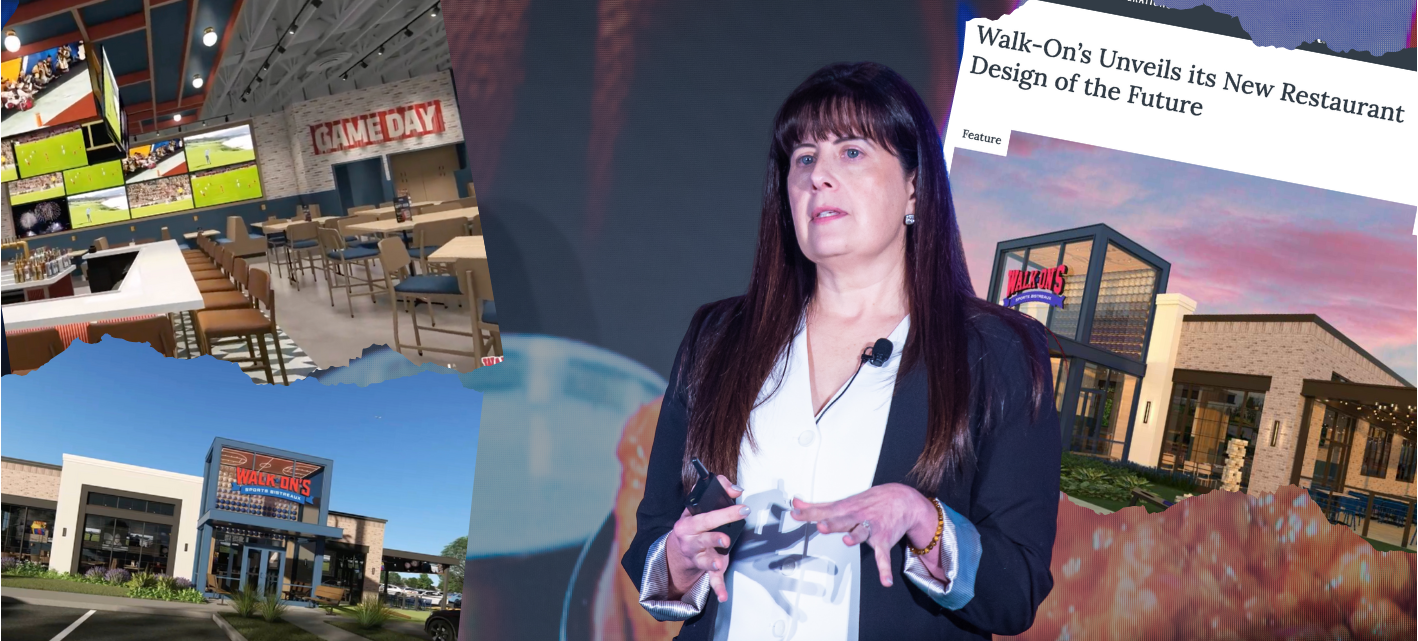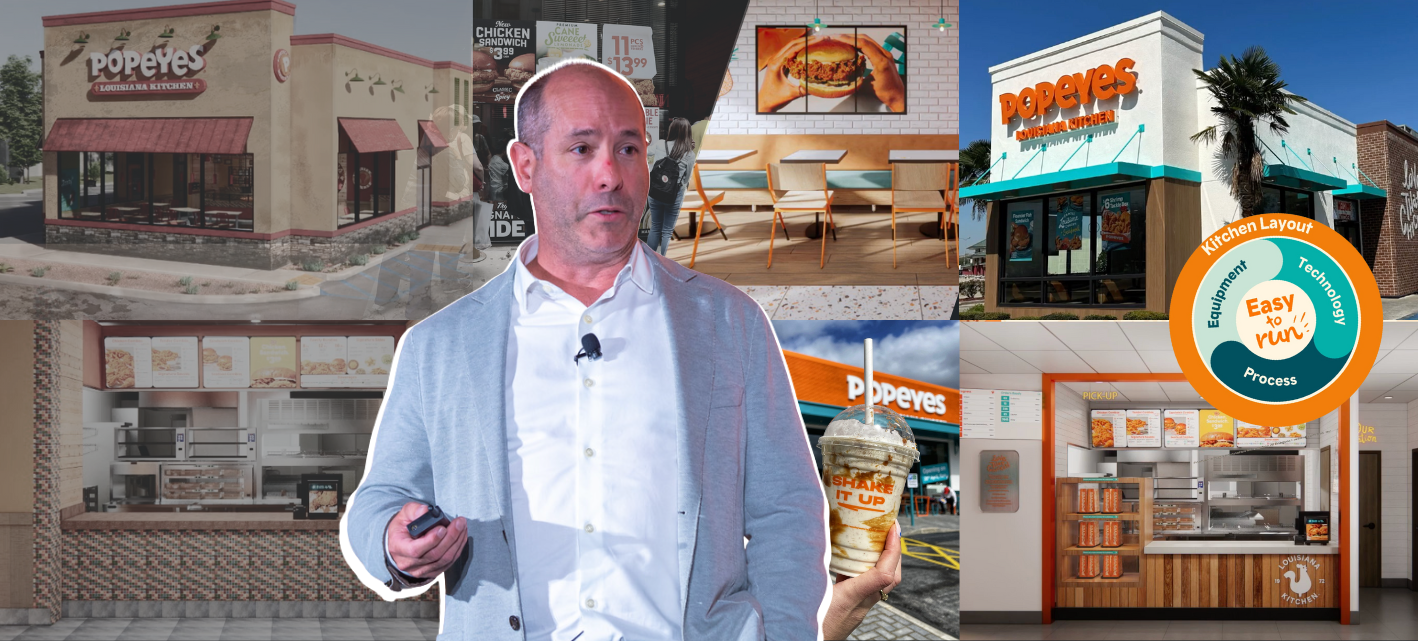Jennifer Striepling admits she sounded like Minnie Mouse by her tenth week at Walk-On's Sports Bistreaux. After visiting tons of locations and talking to everyone from franchisee owners to bussers, her voice was shot, but her mission was crystal clear: this beloved Louisiana-born sports bar concept needed to evolve for the next chapter of growth.
"I asked two questions at every stop," Striepling, Walk-On's Chief Development Officer, told the RestaurantSpaces audience. "If you had a blank piece of paper, knowing what you know now, what would you do again, and what would you not do again?"
The answers painted a picture that many restaurant developers know all too well: a concept that had grown organically over 21 years but was now facing the challenging realities of modern restaurant economics.
The Beast That Needed Taming
Walk-On's original prototype was, in Striepling's words, "a beast to operate." At 11,000 square feet sitting on two and a half acres, the restaurants were impressive but often inefficient. Nearly half of that massive footprint was kitchen space, with 200 to 300 seats scattered throughout. The back of house remained true to Walk-On's from-scratch roots, with everything prepared manually just as it had been since day one at the original Tiger Stadium location – though Striepling noted there were opportunities to introduce technology that could support consistency without changing what made the food special.
But here's what made the challenge particularly complex: guests loved the food. Walk-On's had built a loyal following around their from-scratch kitchen and underdog story, rooted in founder Brandon Landry's seven minutes of playing time as an LSU walk-on. The brand had grown to 80 units across the South, with no plans to stop. Any redesign couldn't sacrifice what made Walk-On's special.
Enter what Striepling calls "protecting the W" – four non-negotiables that would guide every decision: quality, consistency, enhancing the guest experience, and increasing margins.
The Perfect Storm of Rising Costs
As if the operational challenges weren't enough, Striepling presented a slide that every development executive in the room probably recognized: a chart showing construction costs skyrocketing across every category. Steel, concrete, labor, electrical, plumbing – every arrow pointed up, representing a combined 338% increase over recent years.
"This was before the tariffs," Striepling noted, adding another layer of complexity that makes her data even more relevant for today's development landscape.
"This slide has saved me in many board meetings," Striepling confided, "when leadership asks why costs aren't what they were five years ago."
The math was simple but stark: building a traditional Walk-On's would now cost $7-8 million, not including land. For a franchise concept looking to grow, that investment level was becoming prohibitive.
Six Months of 18-Hour Days
What happened next was what Striepling calls "the six-month journey where the team and I really didn't sleep a whole lot." Working seven days a week, 18 hours a day, they embarked on a complete brand evolution that touched every aspect of the business.
The process started with equipment research. If Walk-On's knew what worked on their menu, how could they improve consistency and efficiency? The team literally locked themselves in a warehouse in North Carolina for four weeks, setting up a test kitchen with operations, training, and team members with varying levels of experience – from three days to 13 years.
"I wanted team members with varying experience levels – some with three days, others with 13 years at Walk-On's," Striepling explained. "We'd give them 45 minutes of training on the new equipment, then challenge them to replicate the volume and pace of what our busiest locations handle on their most demanding nights."
The results were remarkable. Not only was food quality more consistent, but ticket times were cut in half – from an average of 17-21 minutes down to 9 minutes flat. Anyone who's worked in restaurant operations knows what that kind of improvement means for table turns and revenue.
The Design Revolution
Working with design partners who went on the road to study existing locations and dive deep into the research, the team reimagined what a Walk-On's could be. To ensure the vision could be executed efficiently, Striepling turned to ACS Architects, who had proven their ability to deliver cost-effective solutions on her previous prototype projects. The new prototype maintains the sports bar DNA but in a radically more efficient package. The bar moves to the center, dining rooms open up with unobstructed views of TVs, and acoustics become a primary focus – addressing the number one complaint from the franchise tour that people wanted to hear the game but also talk to their families.
The structural engineer, Striepling noted with a grin, "really appreciated" the decision to eliminate columns blocking TV views.
The Numbers That Matter
The final prototype tells a compelling story in square footage and dollars:
- 5,500 square feet (down from 11,000)
- 246 seats
- $3.9 million total investment (down from $7-8 million)
- Four fewer back-of-house positions needed
- Ability to go inline or end-cap instead of requiring dirt
"We are no longer tied to dirt," Striepling emphasized, highlighting how the smaller footprint opens up significantly more real estate opportunities.
The People Behind the Process
Perhaps the most important element of Walk-On's success was team building. Striepling quoted hockey coach Herb Brooks: "I'm not looking for the best players, I'm looking for the right ones."
"There is no way in hell we would've done this in six months if I did not have partners from my past or people who were willing to go the distance," she said. The team operated with mutual accountability – everyone could tell anyone no, but they also had to justify the cost or time impact of their decisions.
Looking Forward
Walk-On's is so confident in their new prototype that they're building corporate locations for the first time since 2016. For a brand that's been franchise-focused, that's a significant vote of confidence in their own concept.
The Walk-On's story is ultimately about evolution without revolution – taking everything that made a concept special and finding a way to deliver it more efficiently, more consistently, and more profitably. In an industry where rising costs and operational challenges seem insurmountable, Striepling and her team proved that sometimes the answer isn't just working harder, but working smarter.
Watch the full talk below: 👇

Posted by
Chain Restaurants Reimagined.
The Retreat to Reimagine Restaurant Development, Design + Technology.
April 12-14, 2026 | Miami, FL





-3.png)
-4.png)
-3.png)


Comments